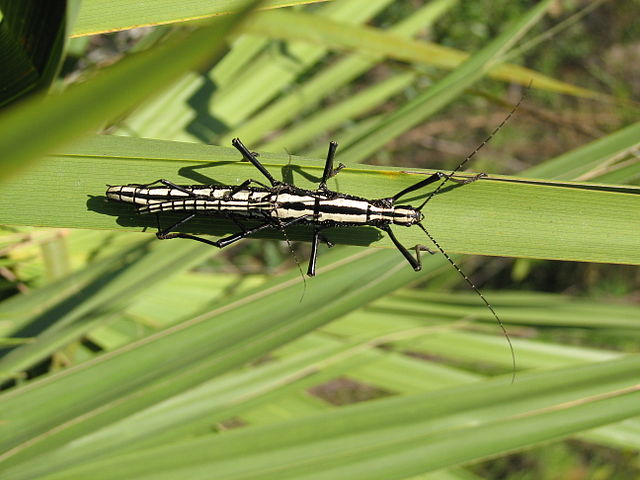Interactions

The three main colors of Anisomorpha buprestoides
plays
a part in the way the two-striped walking stick interacts (Conle et al.
2009; Dossey et al. 2008). The
environment that the brown two-striped walking stick is found
is the more humid vegetative habitat and in addition to only
being found in here they have a tendency to be nocturnal and
social in nature (Conle et al. 2009; Gunning 1987). The
two-striped walking stick usually comes out from under its
shelter roughly 20 to 25 minutes after sunset (Gunning 1987).
This nocturnal behavior is believed to be related to avoiding
predators (Conle et al. 2009). Typically the brown
A. buprestoides can be found hiding out during the day in
large groups under loose bark or in dark crevices in numbers
ranging to 100 specimens (Conle et al. 2009). As in
almost complete contradiction the orange and white A.
buprestoides are typically found solitarily or as solitary
mating pairs (Conle et al.
2009). Regardless of color, however, A. buprestoides
has plenty of predators to worry about (Conle et al.
2009).
A. buprestoides may have a defensive chemical that it
sprays to deter predators, however, there is still no shortage
of them (Conle et al. 2009). Some of the more common
predators to the adult form of A. buprestoides range
from black
bears,
reptiles,
birds and spiders (Conle et al. 2009), although
mice have been recorded to eat them as well (Sondheimer 1970).
One documented event of a mouse eating the southern
two-striped walking stick indicated that A. buprestoides
accurately sprayed the mouse in its eyes and muzzle;
unfortunately for the walking stick the mouse never released the
insect and it was eaten soon after it ran out of its chemical
mixture (Sondheimer 1970). Thankfully the nymphs of A.
buprestoides can spray a defensive spray directly after
eclosion which helps defend against ants (Sondheimer 1970).
Even though the southern two-striped walking stick has many
predators there have been very few studies done in regard to
parasitization (Conle et al. 2009). One incident
of A. buprestoides being specifically related to
parasitization regarded a
red mite (Conle et al. 2009) which was found in the
Ocala National Forest. Unfortunately, the mite was not
officially identified other than being Erythraeidae (Conle et al. 2009). Little is known about the
frequency, regional occurrence, and biological details of this
parasitization.